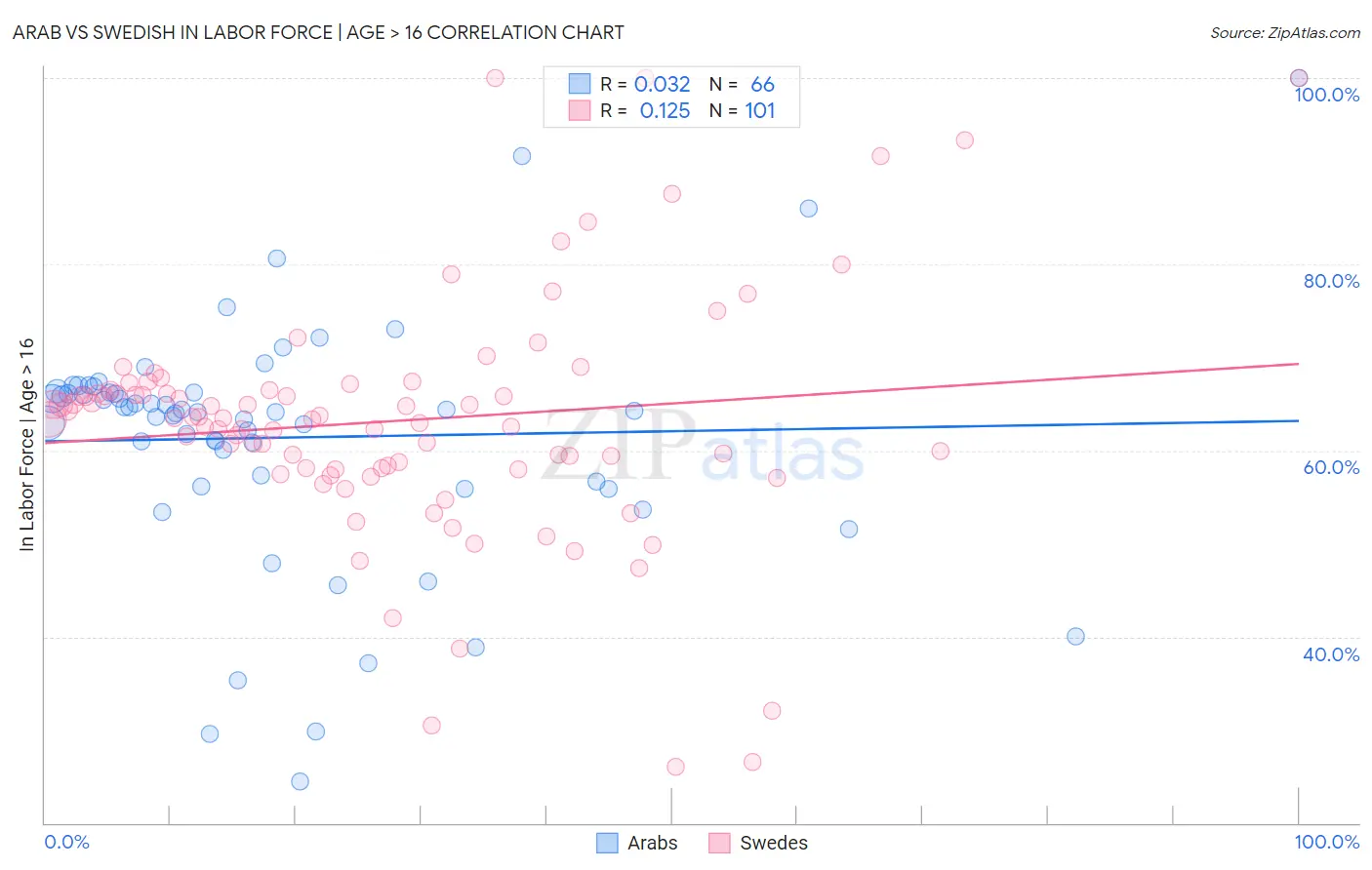Arab vs Swedish In Labor Force | Age > 16
COMPARE
Arab
Swedish
In Labor Force | Age > 16
In Labor Force | Age > 16 Comparison
Arabs
Swedes
65.2%
IN LABOR FORCE | AGE > 16
62.4/ 100
METRIC RATING
169th/ 347
METRIC RANK
65.1%
IN LABOR FORCE | AGE > 16
47.4/ 100
METRIC RATING
176th/ 347
METRIC RANK
Arab vs Swedish In Labor Force | Age > 16 Correlation Chart
The statistical analysis conducted on geographies consisting of 486,878,981 people shows no correlation between the proportion of Arabs and labor force participation rate among population ages 16 and over in the United States with a correlation coefficient (R) of 0.032 and weighted average of 65.2%. Similarly, the statistical analysis conducted on geographies consisting of 539,248,336 people shows a poor positive correlation between the proportion of Swedes and labor force participation rate among population ages 16 and over in the United States with a correlation coefficient (R) of 0.125 and weighted average of 65.1%, a difference of 0.17%.

In Labor Force | Age > 16 Correlation Summary
| Measurement | Arab | Swedish |
| Minimum | 24.4% | 26.0% |
| Maximum | 100.0% | 100.0% |
| Range | 75.6% | 74.0% |
| Mean | 61.4% | 63.1% |
| Median | 64.2% | 63.4% |
| Interquartile 25% (IQ1) | 56.7% | 58.0% |
| Interquartile 75% (IQ3) | 66.2% | 66.5% |
| Interquartile Range (IQR) | 9.5% | 8.5% |
| Standard Deviation (Sample) | 13.1% | 13.0% |
| Standard Deviation (Population) | 13.0% | 12.9% |
Demographics Similar to Arabs and Swedes by In Labor Force | Age > 16
In terms of in labor force | age > 16, the demographic groups most similar to Arabs are Serbian (65.2%, a difference of 0.010%), Immigrants from Israel (65.2%, a difference of 0.010%), Israeli (65.2%, a difference of 0.010%), Immigrants from Sweden (65.2%, a difference of 0.010%), and Immigrants from Belarus (65.2%, a difference of 0.040%). Similarly, the demographic groups most similar to Swedes are Eastern European (65.1%, a difference of 0.010%), Macedonian (65.1%, a difference of 0.030%), Nicaraguan (65.1%, a difference of 0.030%), Trinidadian and Tobagonian (65.1%, a difference of 0.030%), and Immigrants from Haiti (65.1%, a difference of 0.050%).
| Demographics | Rating | Rank | In Labor Force | Age > 16 |
| Albanians | 70.8 /100 | #162 | Good 65.3% |
| South Africans | 69.8 /100 | #163 | Good 65.3% |
| Danes | 68.8 /100 | #164 | Good 65.3% |
| Immigrants | Kazakhstan | 68.1 /100 | #165 | Good 65.3% |
| Immigrants | Western Asia | 67.3 /100 | #166 | Good 65.3% |
| Immigrants | Belarus | 66.0 /100 | #167 | Good 65.2% |
| Serbians | 63.5 /100 | #168 | Good 65.2% |
| Arabs | 62.4 /100 | #169 | Good 65.2% |
| Immigrants | Israel | 61.7 /100 | #170 | Good 65.2% |
| Israelis | 61.6 /100 | #171 | Good 65.2% |
| Immigrants | Sweden | 61.3 /100 | #172 | Good 65.2% |
| Immigrants | Ukraine | 53.7 /100 | #173 | Average 65.1% |
| Macedonians | 50.0 /100 | #174 | Average 65.1% |
| Nicaraguans | 49.7 /100 | #175 | Average 65.1% |
| Swedes | 47.4 /100 | #176 | Average 65.1% |
| Eastern Europeans | 46.2 /100 | #177 | Average 65.1% |
| Trinidadians and Tobagonians | 45.2 /100 | #178 | Average 65.1% |
| Immigrants | Haiti | 43.3 /100 | #179 | Average 65.1% |
| Immigrants | Latvia | 42.9 /100 | #180 | Average 65.1% |
| Immigrants | Panama | 42.4 /100 | #181 | Average 65.1% |
| Immigrants | Nicaragua | 41.1 /100 | #182 | Average 65.1% |